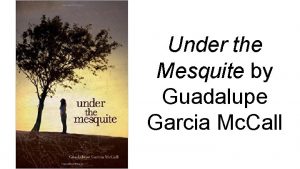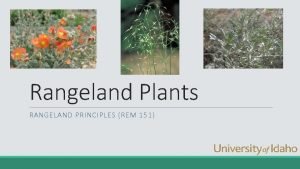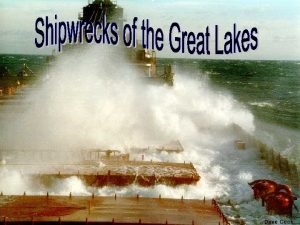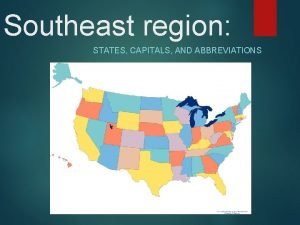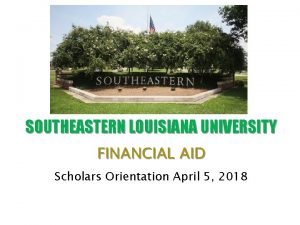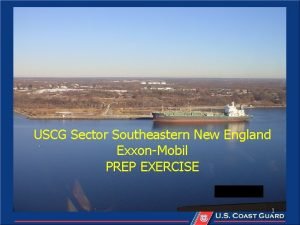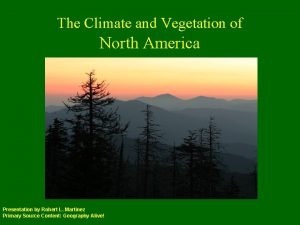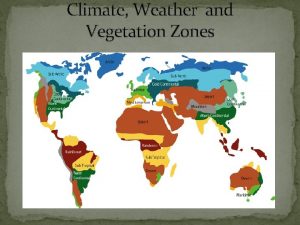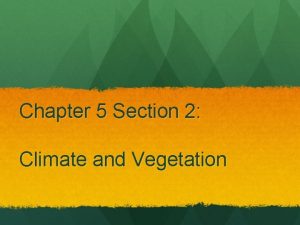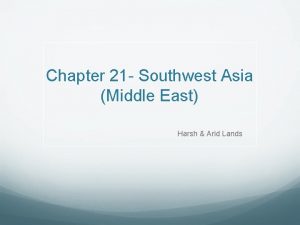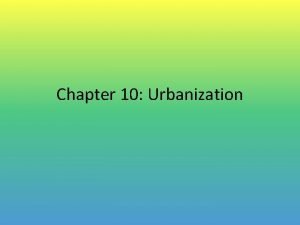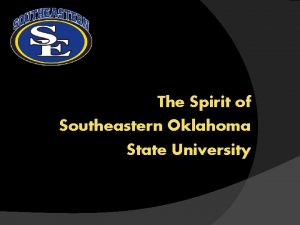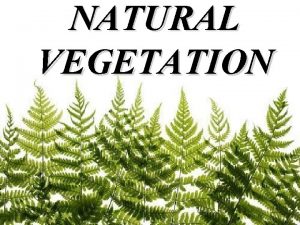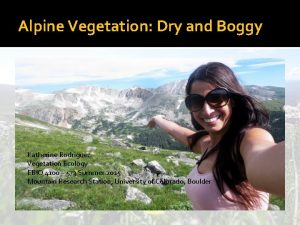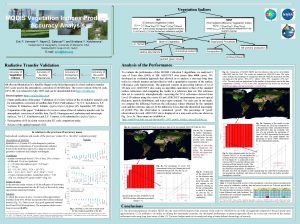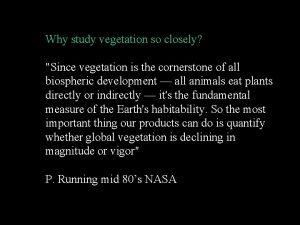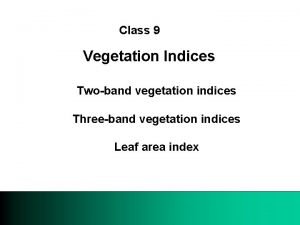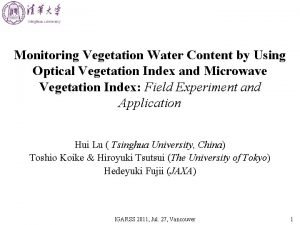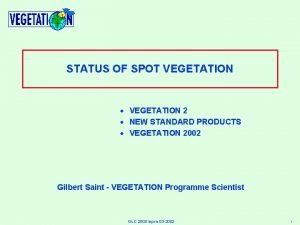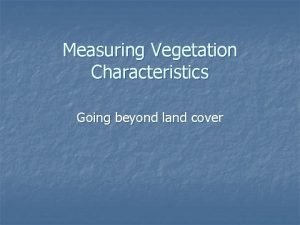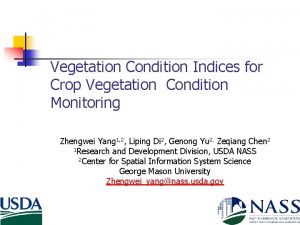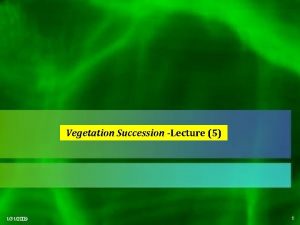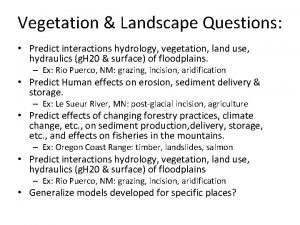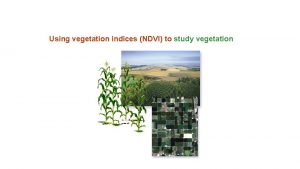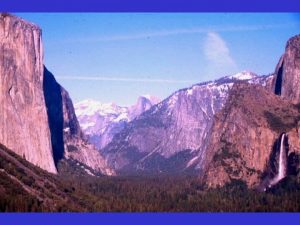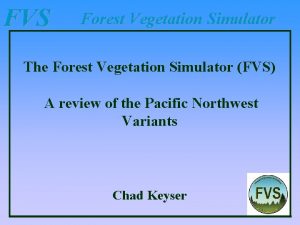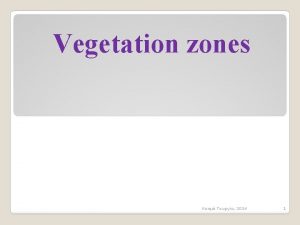VEGETATION CHANGE AND MESQUITE CONTROL IN SOUTHEASTERN ARIZONA









































- Slides: 41

VEGETATION CHANGE AND MESQUITE CONTROL IN SOUTHEASTERN ARIZONA Dan Robinett January 2018

Early Rangeland Scenes Border monument 138, Sasabe, Az. , 1893 Border monument 138, 1983, R. R. Humphrey, 1987

Altar Valley Coyote Mountains, Pima County, 1903 Coyote Mountains, R. Webb, 1999

Mesquite Species 1. Prosopis velutina – Velvet mesquite –the mesquite of the Sonoran desert and grassland region. 2. Prosopis glandulosa var. torreyana – Western Honey mesquite – the mesquite of the Chihuahuan desert and grassland region 3. Prosopis glandulosa var. glandulosa – Honey mesquite – the mesquite of Eastern New Mexico and Texas. These three species were formerly considered varieties of P. juliflora. 4. Prosopis pubescens – Screwbean mesquite – a mesquite of the lower Colorado and Gila River Valleys.

Velvet Mesquite

Western Honey Mesquite

Honey Mesquite

Mesquite - Pros Forage, shade for livestock Habitat for wildlife Food, fuel, shade and landscaping for humans Wood products

Dense mesquite and handling livestock Mesquite - Cons J. Ruth Grassland wildlife Encroachment in riparian systems and water use Low forage production, soil erosion

Mesquite reproduction � � Flowers (perfect) on a cylindrical spike Large amounts of seeds, 2000/pound of pods Persistent germination after 10 years in soil Seeds spread by livestock (pods 14% protein) Over 1000 seeds/cow pie � 13 -22% germination of seeds in range cow manure � � � Seeds also spread by native animals Germinate and establish with summer rains

Mesquite biology � � � Mesquite has extensive lateral roots as well as a deep tap root Mesquite has a concentration of dormant buds found at the rootcrown Plants have ability to store large amounts of energy (carbohydrates) and moisture in stems and roots H. Nessmith, 1972

The Mesquite Problem � � Mesquite thought to be spreading as early as the 1890 s, David Griffiths, J. J. Thornber Mesquite recognized as a problem plant for the range livestock industry in the 1930 s Investigations begin in the 1940 s and 50 s in the Southwest Research results applied in the 1960 s in Arizona University of Arizona Santa Rita Experimental Range, Photographic Archives

Early Research � Dwight Cable, George Glendening, Robert Humphrey, Clark Martin, Harold Paulsen, Ken Parker – SRER � Mesquite seed production, longevity and germination � Mesquite reproduction � Mesquite physiology � Hand cutting, grubbing � Hand application of diesel oil to plant bases. � Aerial spraying of herbicides (2, 4, 5 -T) � Prescribed burning � Forage production � Cost/returns

Research, 60 s and 70 s � � � Clark Martin, Gilbert Jordan, UA Agricultural Experiment Station, SRER Howard Morton, Tom Johnson and Jerry Cox, Agricultural Research Service, Tucson, Az. New herbicides Forage production Erosion control Rangeland seeding

Hand cutting or grubbing mesquite � Hand cutting and herbicide application Large trees � Labor intensive � University of Arizona Santa Rita Experimental Range, Photo Archives � Hand grubbing, 1958 Jornada study � � � � C. Herbel 4265 acres Plants < 30” crown diameter Sandy soils 40 -100 plants / acre 30 foot spacing of workers 0. 65 man hrs. / acre $0. 45 / acre cost

Mesquite control using diesel oil � Basal application of diesel oil at soil level � Must be enough to penetrate to the bud zone � One gallon treats 4 -8 medium sized trees (6 -10” diameter) � Can be applied anytime the soil is dry � Chemically girdles the mesquite plant 85% kill on upland mesquite 35% kill on bottomland mesquite University of Arizona Santa Rita Experimental Range, Photographic Archives

Broadcast herbicide application � Herbicide 2, 4, 5 -T. 5 to. 75 lb. acid equiv. /acre � 1: 4, diesel/water emulsion � Applied 4 gallons per acre. � � Applied Late May to early June � Leaves fully formed but before wax forms on the leaves and plants are in flower � Two applications a year apart needed for reasonable control � 90% crown kill 50% mortality University of Arizona Santa Rita Experimental Range, Photographic Archives

Broadcast herbicide application, results � � 20 year study (Cable, SRER 1954 -74) Chemical treatment Doubled forage production for six years � Lehmann lovegrass dominates after 1963 � � After 20 years � � No significant difference between treated and untreated areas Areas on private ranches � Altar Valley treated in the 1960 s Single spray Poor results. University of Arizona Santa Rita Experimental Range, Photographic Archives

Mechanical control of mesquite � � � Development of machinery to control mesquite 1940 s Costs then � $10 - $25/ac. Costs now � $500 -1000 / ac. Archaeology T&E species Cost / benefit ? Land imprinter, 1985 Chaining, 1976, H. Nessmith

Mechanical methods for mesquite control, cont. Tree masticator Tree shear Backhoe or excavator to extract mesquite Root plow

� Control burning research � SRER – Humphrey (1951) Burroweed control high 85% + � SRER– Cable (1967) Low and high elevations, June 1952 and 1955 �Burroweed control high 85%+ �No difference in ann. grass prod. �No difference in peren. grass prod �Mesquite mortality very low �Burroweed recovered by 1965 �Drought period � Fire for shrub management Burroweed Mesquite – Cable (1965) Hot wildfire in June 1963 Fine fuel loads � 4500 lbs/ac fine fuel = 25% mortality � 2200 lbs/ac fine fuel = 8% mortality University of Arizona Santa Rita Experimental Range, Photographic Archives

Repeat fire and mesquite management � Audubon Research Ranch (Bock, Kennedy, 2007) � Fires in July 1987 and again in April 2002 � 18% mortality of velvet mesquite on ARR after two fires (1% after 1987 fire) � No mortality of mesquite on grazed area Audubon Research Ranch, 12 -1 -14

May 1985 Prescribed fire � Altar Valley � 10, 000 acres burned � 1985 through 1993 � 1800 lbs/ac (air dry) fine fuel � May – June timing � < 5% mesquite mortality � Excellent control of burroweed June 1985 Anvil Ranch, West Mill, KA 3, prescribed fire in June 1985 Oct. 1988

11 -24 -98 Wildfire 5 -9 -02 9 -20 -07 Babaquivari Ranch, Thomas Canyon, KA 2, wildfire in May 2002

Mesquite control and maintenance � � Any type of mesquite control will require maintenance to have adequate lifespan A 2014 study on SRER found that mesquite � Re-infested treated areas within 6 years 10% canopy � Maintenance is needed within 5 – 15 years Clara Miller

Mesquite control and maintenance, cont. � Remedy (triclopyr), Reclaim (clopyralid) Aerial foliar spray � Soil temperatures > 75 degrees � Mid June – August � � The hardest part of foliar applied herbicide is getting the material into the plant and translocated to the crown

Small Watersheds, SRER � Eight, paired watersheds, 1974. (Martin, Morton, 1993) 13 years � Erosion (head-cut advance) less with mesquite treatment � Grass density increased with mesquite treatment � Lower elevation = 2. 5 times annual soil loss of higher elevations � Watersheds 5 – 6, contrasting soils negated results � Sediment yield Highest WS 4 Lowest WS 6 Both Sandyloam deep ES Both with mesquite treatment

Small Watersheds, SRER, cont. � Flume at watershed 4, 2015 Polyakov, Nearing, Nichols, Scott, Stone and Mc. Claran, 2010, 34 years � Not possible to evenly pair watersheds No significant differences in erosion / runoff, treated vs untreated (WS 5, 6) � Increased erosion / runoff 1994 -1998 (1994 fire) � Increased erosion / runoff 2000 -2006 (drought 200206) � Same trend in sediment yield from low to high elevations � WS 4 highest at 6. 69 tons/ha/yr WS 6 lowest at 0. 85 tons/ha/yr Flume at watershed 7, 2015

� Repeat Photography and mesquite on SRER Archer and Browning, 2008 Mesquite uncommon on uplands in 1902 � By 1936 mesquite increased on sandy soils (Sandyloam Deep ES) � By 1966 mesquite had increased on soils with clayloam subsurface horizons (Sandyloam Upland Loamy Upland ES) � High clay soils (Loamy Upland sites) still have low covers of mesquite Rodent Station � # 111 486 Road 1936 SCS aerial photo

Mar 1969 Dec 1922 Sandyloam Upland, 12 -16 inch pz. Rodent Station, Pasture 12 south Jan 2016 Photo station 111 University of Arizona Santa Rita Experimental Range, Photographic Archives

Other Studies on the SRER � Tiedemann, Klemmedson, 2004 Mesquite treatment in 1966 � Greatest cover of Arizona cottontop, plains bristlegrass and bush muhly under the canopy of intact mesquite � Mature mesquite should be considered as a refuge for native grass species � Sandyloam Deep 12 -16” pz. Mesquite - native grass state

Other Studies on SRER � Mc. Claran, Angell 2006 � Mesquite treatment in 1957 � 46 years � 24 plots � 1031 m elevation, 350 mm. precip. � Findings � Mesquite cover varied with � � treatment Perennial grass cover did not vary with treatment Burroweed cover did not vary with treatment Perennial grass density – only threeawn species increased with treatment Little potential for increasing perennial grass in dry (< 350 mm precip) sites and < 20% mesquite cover

� Dalke, 2012 UA Ms Thesis Paired study at exclosures � Measured species abundance � Three ecological sites � Findings � Other Studies on the SRER Mesquite least abundant on high clay soils (loamy upland) Native grass most abundant on low clay soils (Sandyloam deep) Lehmann lovegrass most abundant on high clay sites Mesquite cover favors native grass abundance Un-grazed favors native grass abundance Total grass abundance related negatively to increasing mesquite cover SRER, exclosure #11, Whitehouse Station

� Perlinsky, Paige, Mc. Claran, 2014 � STM for ecol sites in MLRA 41 -3 � Monitoring since 1957 � Single mesquite treatment Won’t restore functionality Mesquite recovers to threshold level (10%) cover within 6 years (70%) � Lehmann lovegrass threshold � Between 1 -2 % basal cover Reached - 6 years of introduction (76%) Williamson, et. al. 2016 40+ year data set � Test utility of Ecological Sites in interpreting monitoring data � Findings � The pattern of mesquite and Lehmann expansion was different for three ES classes in MLRA 41 -3 � Sandyloam Deep � Sandylaom Upland � Loamy Upland Other Studies on SRER, cont.

Sandyloam Deep Upland 12 -16” pz � � Young soils Deep, coarse textured High infiltration, low water holding capacity, droughty Shrubs in the plant community � � Burroweed, snakeweed, catclaw acacia, desert hackberry Trees reinvade quickly Selective control methods (mechanical or hand applied herbicide) Recommend leave 5 -10% canopy older trees Species diversity � Native grass refuge � Wildlife habitat � Combate soil series, SRER

Sandyloam Upland 12 -16” pz � � Lehmann, mesquite state Medium aged soils Deep, thick coarse textured surfaces, clayloam subsoils Good infiltration, high water holding capacity Sub-shrubs mainly burroweed, snakeweed � � Good candidate for broadcast herbicide to control mesquite Mechanical control for mesquite � � In eroded state ? Recommend leave 1 -5% canopy older trees Species diversity � Wildlife habitat � Eroded state

Loamy Upland 12 -16” pz � � Old soils Deep soils, thin coarse textured surfaces, clayey subsoils Moderate infiltration, high water holding capacity Sub-shrubs in the plant community (False mesquite, Range ratany, Desert zinnia, Shrub buckwheat) � Compete well with Lehmann lovegrass � May be killed with broadcast herbicide � Selective control for mesquite � Altar Valley Where sub-shrubs are present Recommend leave 1% mature canopy Species diversity Wildlife habitat SRER

� Perennial grass Biomass and basal cover unaffected by removal at lower elevations � Biomass and basal cover responded positively at mid and high elevations for <20 -30 years � � Summary Paired Watershed studies Differences in partial areas, soils, etc. = WS pairs not equal � Need long pre treatment monitoring � � Mesquite invasion � � � SLD first, SLU next, LU last Single treatment will not restore functionality Mature canopy a reservoir for native grass species Long term data sets an asset for research ES classification helps in planning and monitoring S&T Models with thresholds, temporal scales based on data Florida Station, SRER

� � � � � Cable, D. R. 1967. Fire effects on semidesert grasses and shrubs. Journal of Range Management. 20: 170– 176. Cable, D. R. , 1965. Damage to Mesquite, Lehmann Lovegrass, and Black Grama by a Hot June Fire. Journal of Range Management. Vol. 18, No. 6: 326 -329 Cable, Dwight R. 1976. Twenty Years of Changes in Grass Production Following Mesquite Control and Reseeding. Journal of Range Management. Vol. 30(1) pp. 4 -11. Glendening, George E. and Harold A. Paulsen, 1955. Reproduction and establishment of velvet mesquite, as related to invasion of semi-desert grasslands. USDA Tech Bulletin 1127, 1955 Humphrey, Robert R. And A. C. Everson, 1951. Effect of Fire on a Mixed Grass-Shrub Range in Southern Arizona. Journal of Range Management. Vol. 4, No. 4: pp. 264 -266 Jordan, Gilbert L. 1981, Range Seeding and Brush Management on Arizona rangelands, Coop Ext. Agric. Experiment Station. University of Arizona, College of Agriculture, T 8 -1121. Martin, S. C. 1970. Longevity of velvet mesquite seed in the soil. Journal of Range Management. 23: 69– 70. Martin, S. Clark. 1975. Ecology and management of Southwestern, semi-desert grass-shrub ranges: the status of our knowledge. Res. Pap. RM-156. Fort Collins, CO: U. S. Department of Ag. Forest Service, Rocky Mountain Forest and Range Experiment Station. 39 p. Parker, Kenneth W. ; Martin, S. Clark. 1952. The mesquite problem on southern Arizona ranges. Circ. 908. Washington, DC: U. S. Department of Agriculture. 70 p. References, Older publications

References, Newer sources � � � Browning, D. M. , S. R. Archer, G. P. Asner, M. P. Mc. Claran, and C. A. Wessman. 2008. Woody plants In grasslands: post-encroachment stand dynamics. Ecological Applications, 18(4), pp. 928– 944 Bock, Carl E. , Linda Kennedy, Jane Bock and Zach Jones. 2007. Effects of fire frequency on velvet mesquite in an Arizona grassland. Rangeland Ecology and Management, 60: 508 -514. Dalke, Amber. 2012. Native and Introduced grasses have different responses to livestock, mesquite and soil texture. Thesis Submitted to the Faculty of the School of Natural Resources and the Environment, University of Arizona. Martin, S. C. and H. L. Morton. 1993. Mesquite control increases grass density and reduces soil loss in southern Arizona. Journal of Range Management. Vol. 46(2): 170 -175. Mc. Claran, Mitchel P. 2003. A Century of Vegetation Change on the Santa Rita Experimental Range. In: Santa Rita Experimental Range: 100 Years (1903 – 2003) of Accomplishments and Contributions, USFS Rocky Mountain Research Station. P 30. pp. 16 -33. � � � Polyakov, V. O. , M. A. Nearing, M. H. Nichols, R. L. Scott, J. J. Stone, and M. P. Mc. Claran, 2010. Long‐term runoff and sediment yields from small semiarid watersheds in southern Arizona. Water Resources Research, Vol. 46, W 09512, doi: 10. 1029/2009 WR 009001. Perlinsky, Anthony T. Ginger B. Paige, and Mitchel P. Mc. Claran. 2014, Evaluating a State -and-Transition Model Using a Long-Term Dataset, Rangeland Ecol ogy and Management 67: 173– 182. Tiedemann, Arthur R. and James O. Klemmedson. 2004. Responses of desert grassland vegetation to mesquite removal and regrowth. Journal of Range Management. Vol. 57: 455 -465. Williamson, Jeb C. , Brandon T. Bestelmeyer, Mitchel P. Mc. Claran, Dan Robinett, David D. Briske, X. Ben Wu, and Maria Fernandez. Gimenez, 2016. Can ecological land classification increase the utility of vegetation monitoring data? Ecological Indicators. Volume 69. Yuan, W. Nie, Y. , Kepner, W. Erickson, C. Jackson, M. . 2012 Hydrological impacts of mesquite encroachment in the upper San Pedro watershed, Journal of Arid Environments , 82 , 147 -155.

Books, Vegetation Change in Southern Arizona � � � Bahre, Conrad J. 1991. A Legacy of Change; historic human impact on vegetation in the Arizona borderlands. University of Arizona Press, Tucson, Arizona. 231 pp. Humphrey, Robert R. 1987. 90 Years and 535 Miles; vegetation changes along the Mexican border. University of New Mexico Press, Albuquerque, New Mexico. 448 pg. Mc. Claran, Mitchel P. and Thomas R. Van Devender. 1995. The Desert Grassland. The University of Arizona Press, Tucson, Arizona. 346 pp. Turner, Raymond M. , Webb, Robert H. , Bowers, Janice E. and James Robert Hastings. 2003. The Changing Mile Revisited. The University of Arizona Press. Tucson, Arizona. 334 pp. Webb, Robert H. , Stanley A. Leake and Raymond Turner. 2007. The Ribbon of Green: Change in Riparian Vegetation in the Southwestern United States. The University of Arizona Press. Tucson, Arizona. 462 pp
 Under the mesquite
Under the mesquite Common curly mesquite
Common curly mesquite Mesquite ancestral state reconstruction
Mesquite ancestral state reconstruction Mesquite shipwreck
Mesquite shipwreck Southeast region abbreviations
Southeast region abbreviations Atakapans
Atakapans Southeastern universities research association
Southeastern universities research association Southeastern states pupil transportation conference
Southeastern states pupil transportation conference Southeastern louisiana university financial aid
Southeastern louisiana university financial aid Uscg sector southeastern new england
Uscg sector southeastern new england Examples of physical change
Examples of physical change Absolute change and relative change formula
Absolute change and relative change formula Whats the difference between chemical and physical change
Whats the difference between chemical and physical change Supply and demand curve shifts
Supply and demand curve shifts Physical and chemical changes examples
Physical and chemical changes examples Rocks change due to temperature and pressure change
Rocks change due to temperature and pressure change Physical change and chemical change venn diagram
Physical change and chemical change venn diagram First-order change
First-order change Arizona fair wages and healthy families act
Arizona fair wages and healthy families act Arizona league of cities and towns
Arizona league of cities and towns Arizona state savings and credit union
Arizona state savings and credit union Product control
Product control Difference between positive and negative control
Difference between positive and negative control Control flow errors
Control flow errors Painting a wall physical or chemical change
Painting a wall physical or chemical change Integer number
Integer number Input and output market
Input and output market Enagic compensation plan
Enagic compensation plan Proactive vs reactive change
Proactive vs reactive change Spare change physical versus chemical change
Spare change physical versus chemical change Physical change
Physical change How does a physical change differ from a chemical change?
How does a physical change differ from a chemical change? Is chopping wood a physical change or a chemical change
Is chopping wood a physical change or a chemical change Climate change 2014 mitigation of climate change
Climate change 2014 mitigation of climate change Canadian vegetation regions map
Canadian vegetation regions map Vegetation of north america
Vegetation of north america Name the type of natural vegetation of karnataka
Name the type of natural vegetation of karnataka Climate and vegetation zones
Climate and vegetation zones Chapter 5 section 2 climate and vegetation answer key
Chapter 5 section 2 climate and vegetation answer key Chapter 21 section 2 climate and vegetation
Chapter 21 section 2 climate and vegetation Uncentered commercial (strip) development
Uncentered commercial (strip) development Australia climate and vegetation
Australia climate and vegetation
